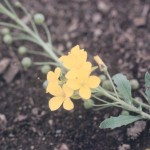Gordon's Bladderpod
Physaria gordonii (Lesquerella gordonii)
Brassicaceae
Description
Gordon’s Bladderpod is a densely pubescent, multi-stemmed forb in the Mustard (Brassicaceae) family. It is typically an annual but may also be a short-lived perennial. The root system’s slender taproot is relatively weak, which is often a characteristic of annual plants. This can be helpful when trying to distinguish Gordon’s Bladderpod from other bladderpods, which are perennial and have heavier, deeper root systems. Its hairy stems are often decumbent (growing horizontally and then rising at the tip) and may reach around 14 inches or 35 cm long. The leaves of Gordon’s Bladderpod are sparse, small, alternate, oblanceolate to linear, and covered with silvery-gray hair. The leaves are dense at the stem base becoming shorter and fewer as you go up the stem. The basal leaves may have petioles but, again, as you go up the stem, they become sessile. Leaves measure 2 to 3 inches or 5 to 8 cm long. The small, four-petaled flowers are bright yellow to orange and fade to reddish as they mature. Bloom time is as early as February and as late as June. The flowers are in compact clusters measuring 2 cm (about 0.79 in) which lengthen as the plant develops fruit. The hollow seedpods are spherical, reddish-brown, with a persistent style, and measure about 0.1 to 0.3 inches or 3 to 8 mm long. This plant is eaten by all kinds of livestock and deer. Because of its early blooming, it provides green vegetation as winter ends.Habitat
These plants are found in gravelly or sandy soil in pastures, in open fields, on hillsides, and along roadsides in the western half of Texas in a very wide variety of soil types except scarce on sandy loam. They can become very widespread in some years with truly remarkable blooms.Toxic Agent
The toxic agent of Bladderpod is not known. Although this plant has been associated with "stocking up" swelling of the lower legs) in horses, poisoning has not been confirmed by experimental trials. Feeding Hoary Alyssum (Berteroa incana), a mustard of the northern United States, reproduced the clinical signs. Problems are seen in Texas when a wet winter and spring followed a drought, and horses on pasture are exposed to many of these plants in the flower and seedpod stage.Signs of Livestock Ingestion
Only horses are affected and they may show the following clinical signs: High temperature; Depression; Edema of the lower body; Swollen legs; Founder.Management Strategies
In spring, do not place horses in pastures "yellow" with Gordon’s Bladderpod. Horses usually respond favorably if they are removed from the contaminated pastures in the early stage of the disease. These plants must constitute a large portion of the diet to induce poisoning. Good pasture management along with adequate desirable forage will prevent poisoning.Images
Plant Characteristics
Flower Color: Orange, Yellow
Seed Type: Bean/Pod
Duration: Annual
Stem Texture: Hairy
Growth Habit: Forbs/Broadleaf
Leaf Shape
 : Simple with Pinnate or Parallel Venation
: Simple with Pinnate or Parallel Venation
Season: Warm
Distribution
 : 04 - Blackland Prairies, 05 - Cross Timbers and Prairies, 06 - South Texas Plains, 07 - Edwards Plateau, 08 - Rolling Plains, 09 - High Plains, 10 - Trans-Pecos
: 04 - Blackland Prairies, 05 - Cross Timbers and Prairies, 06 - South Texas Plains, 07 - Edwards Plateau, 08 - Rolling Plains, 09 - High Plains, 10 - Trans-Pecos
Distributions
Distribution refers to the ecological region in Texas that a plant has been found. You can also view a clickable map.
Book: Toxic Plants of Texas (B-6105)
Collection: Toxics, Wild Flowers
Livestock Affected: Horses
Livestock Signs: Depression/ Weakness




